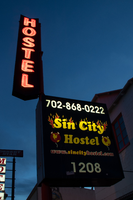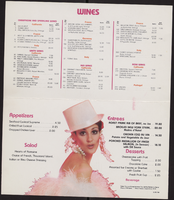Search the Special Collections and Archives Portal
Search Results

Meeting minutes for Consolidated Student Senate University of Nevada, Las Vegas, November 15, 1984
Date
Archival Collection
Description
Text
Rinker, C. A. Earle (Cleveland A. Earle), 1883-1965
Cleveland A. Earle Rinker was born in Indiana in 1883 to S. Cleveland Rinker and Isadora (Fenwick) Rinker. Shortly after his twentieth birthday Rinker went to Parker, Indiana, seeking work as a stenographer. He soon began working as a clerk for Thomas Condon, a coal and oil dealer who was also an enthusiastic investor in Nevada gold mines. Condon encouraged Rinker to seek his fortune in the gold fields and, in late October of 1906, Rinker boarded a train to make the journey to Goldfield, Nevada.
Person

Film strip of individuals or Hoover Dam construction, image 006: photographic print
Date
Archival Collection
Description
Image

neo000139-004
Description
Notes: The logo cabinets which adorn the entrances on the elevated walkways: The letters start with both rows of text in the off position. The top row flashes on, while the bottom row is dark then the bottom row illuminates, as the top row goes dark. Once the top row flashes off it flashes back on so that both rows of text are briefly illuminated simultaneously before they both go dark and the sequence stars over again. While this is going on the incandescent bulbs which line all of the raceways are chasing each other from left to right on the horizontal planes, while the arched sections chase each other downward. The triangular peaks which radiate around the top of the logo sign, flash on and off in a sequence which chase each other downward. First the top center peak flashes on, then the next sequential triangular channel on both sides illuminate simultaneously, flash off, then the next two in the series illuminate. The resultant effect is a chasing pattern starting from the top. The sister animation is located on almost the exact same design on the porte cochere. I would think the previous smaller sign would be based on the larger porte cochere. The other variance besides obvious size difference is the that the channel letters are filled with incandescent bulbs instead of neon. The animation is a bit simpler as well. The incandescent bulbs oscillate continuously while the triangular pan channels which create the radiating crown, animate. The neon in the channels chase each other as described in the smaller walk way version, while the text continues until the entire text flashes off, then on, off, then begin to animate once again. All of the bulbs, which line the raceways of the exterior edge of the porte cochere, as well as the encrustation of bulbs on the brass bull nose portion, animate in rapid succession. All the raceway bulbs chase each other while the bulbs on the brass portion continually oscillate. Animation continues on the east face of the building with the entrances first. The principle for these two signs is oscillation and chasing. All bulbs on the underside of the entrance, as well as in the logo, oscillate rapidly. All bulbs on the raceways chase each other. Further on the surface of the building as well, the Pepsi cola wall sign is found displaying a very unique form of animation, seen here on the strip. The signage for the Pepsi ad is located on the eastern wall. (Detailed in specific description) The Incandescent bulbs which fill the inside of the text that spells Pepsi, chase each other from left to right, leaving all the bulbs in its path illuminated, as if writing out the word Pepsi. The neon bars located within the tilted bottle of Pepsi are illuminated, and chase each other downward, leaving the bars it its path dark. As this sequence in taking place, the waving tubes of neon illuminate, flashed subtly making the neon appear as soda pouring out of the bottle. As the tubing flows then the vertical neon bars in the cup illuminate one at a time making the cup appear as if it is filling up. The text above each of the painted fires head, flashes back and forth as if talking to each other as well. ESPN ZONE animation: The letters in the vertical blade portion of the ESPN Zone illuminate one at a time, starting from the top. Once the entire phrase is lit, in flashes off then on then off, before restating. The orange and red neon tubing which resides inside the pan channels that represent flames flash on and off in a relaxed manner as if to animate the flickering of the flames. The small incandescent bulbs on the black portions above the main matrix reader board flash on and off subtly.
Sign keywords: Neon; Backlit
Jerry Morlan Professional Papers
Identifier
Abstract
This collection contains material that documents the career of technology educator Jerry Morlan (1938-2000), primarily in Las Vegas, Nevada. The bulk of the materials date between 1986-1996 and refer to Morlan's role in integrating technology into the classroom in the Clark County, Nevada School District. They include numerous letters of thanks and recommendation from schools throughout the county, as well as Morlan's professional writings and newspaper clippings related to his advocacy of vocational learning in the industrial arts. Also included in the collection is a group of photographs that visually document student projects Morlan directed during the 1980s, as well as a videocassette program from 1991 that offered an introduction to technology.
Archival Collection
Alex Shoofey Papers
Identifier
Abstract
The Alex Shoofey Papers are comprised of records spanning 1967 to 1972 that primarily pertain to financial operations and policies for the International Hotel and Casino-Las Vegas Hilton and the Flamingo Hotel in Las Vegas, Nevada. The collection includes daily profit and loss reports, interdepartmental correspondence, staffing and operational policies and procedures, production reports, and Shoofey's personal correspondence. Collection materials are representative of business and financial records from Shoofey's tenure as president of both the International and Flamingo hotels and casinos.
Archival Collection
Gilbert Schwartz Papers
Identifier
Abstract
The collection documents Gilbert Shwartz's early involvement with the Clark County Sheriff's Mounted Posse and the Elks Club in the early 1960s as well as the growth of his real estate company, Sahara Realty, from 1963 to 2008. The collection includes photographs and programs of the Clark County Sheriff's Mounted Posse Rodeo and programs for the Elks Club Helldorado Days Rodeo from the early 1960s. The collection also includes photographs of Schwartz and his home, slides of Sahara Realty/Realtors advertising around Las Vegas, and autographed team photographs of the Central Little League teams sponsored by Sahara Realty. Also included is a program for the National Association of Real Estate Brokers annual conference held in Las Vegas in 1974.
Archival Collection
Julian Taber Collection on Gambling Addiction
Identifier
Abstract
The Julian Taber Collection on Gambling Addiction (1977-1988) includes papers, proposals, internal reports, memoranda, and newspaper articles chronicling the work of Julian Taber, an early specialist in the field of gambling addiction. The majority of the collection relates to Taber’s work and pilot programs at the Brecksville Veterans Administration (VA) Hospital in Brecksville, Ohio, with select materials pertaining to an alcohol dependency treatment program he coordinated at the VA hospital in Reno, Nevada.
Archival Collection
Underground House of Las Vegas Collection
Identifier
Abstract
The Underground House of Las Vegas Collection (1964-2004) consists of newspaper clippings, magazine articles, books, photographic prints, and digital images detailing the construction and history of Girard "Jerry" B. Henderson’s "Underground House," a Las Vegas underground dwelling completed in 1978.
Archival Collection

